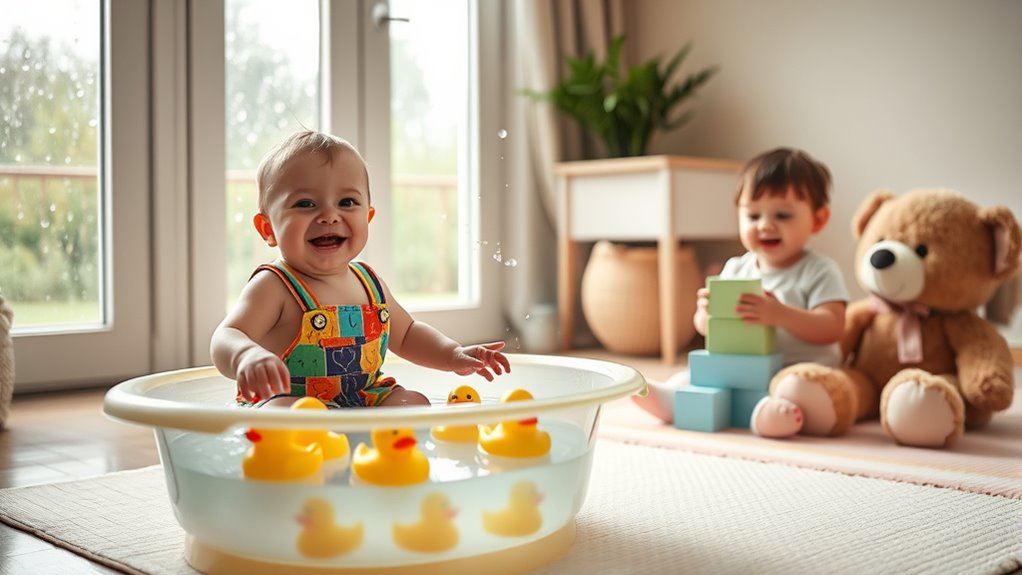On rainy days, keep your babies and toddlers happily engaged with indoor activities like sensory play with rice or water, creative arts such as finger painting, and building obstacle courses with cushions or tunnels. You can also encourage storytelling and music fun with nursery rhymes and instruments. Plus, craft DIY toys from household items for endless entertainment. Stay tuned to discover even more ways to make indoor days fun and enriching for your little ones.
Key Takeaways
- Engage in sensory play with bins of rice, beans, or pasta plus toys to develop fine motor skills and curiosity.
- Create art projects like finger painting, handprint collages, and rainbow designs for self-expression and motor development.
- Set up indoor obstacle courses with cushions, tunnels, and furniture to boost gross motor skills and confidence.
- Incorporate singing, musical instruments, and storytelling to enhance language, rhythm, and emotional bonding.
- Make DIY toys using household items, puzzles, and recycled materials to promote problem-solving and sensory exploration.
Sensory Play Ideas to Stimulate Young Minds
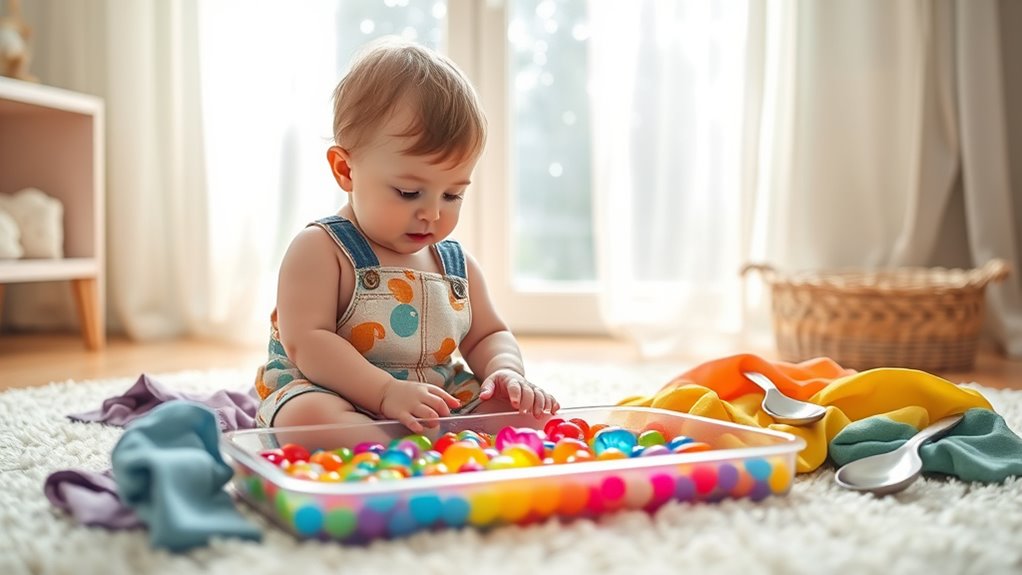
When it’s pouring outside, sensory play offers a perfect way to keep your baby or toddler engaged and stimulated indoors. Sensory play can also support mental clarity and health by promoting focus and calming the mind. Sensory bins are a fantastic option, allowing your little one to explore different textures and materials safely. Fill a bin with rice, beans, or pasta, and add small toys or scoops for added fun. Water play is another excellent activity—fill a shallow container with water and provide cups, sponges, or waterproof toys. Your child will love pouring, splashing, and feeling the water’s cool texture. These activities promote fine motor skills, curiosity, and sensory development without any mess on the floor. Incorporating mindfulness techniques into your routine can help enhance your child’s focus and emotional well-being during these indoor activities. Practicing deep breathing exercises together during playtime can further promote relaxation and emotional regulation. Keep a close eye, and let your child’s imagination and senses flourish during these simple, engaging indoor activities.
Creative Arts and Crafts for Little Artists
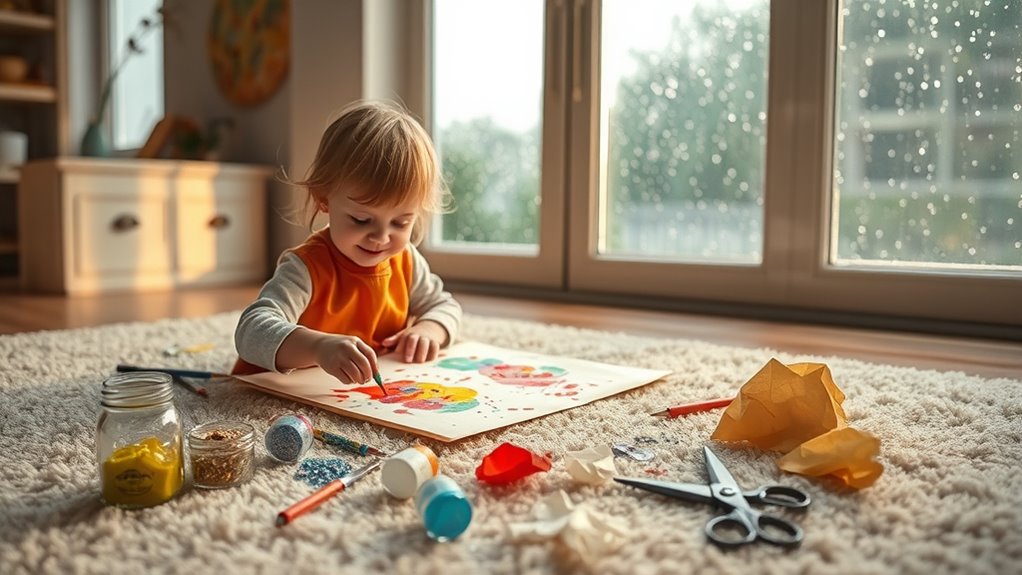
Indoor rainy days are the perfect opportunity to release your child’s creativity through arts and crafts. You can turn a simple session into a memorable bonding experience with activities like finger painting and making handprint keepsakes. Watching their little fingers spread paint across paper sparks joy and pride. Encourage your child to explore colors and textures, creating unique masterpieces. You might feel proud seeing their tiny handprints pressed onto paper or turning a finger painting into a colorful scene. These activities help develop fine motor skills and self-expression. Plus, they leave you with adorable, heartfelt artwork to cherish.
- Create a vibrant rainbow with finger paints
- Make a family handprint collage
- Design fun, messy abstract art
- Celebrate your little artist’s progress and creativity
Indoor Obstacle Courses for Active Toddlers
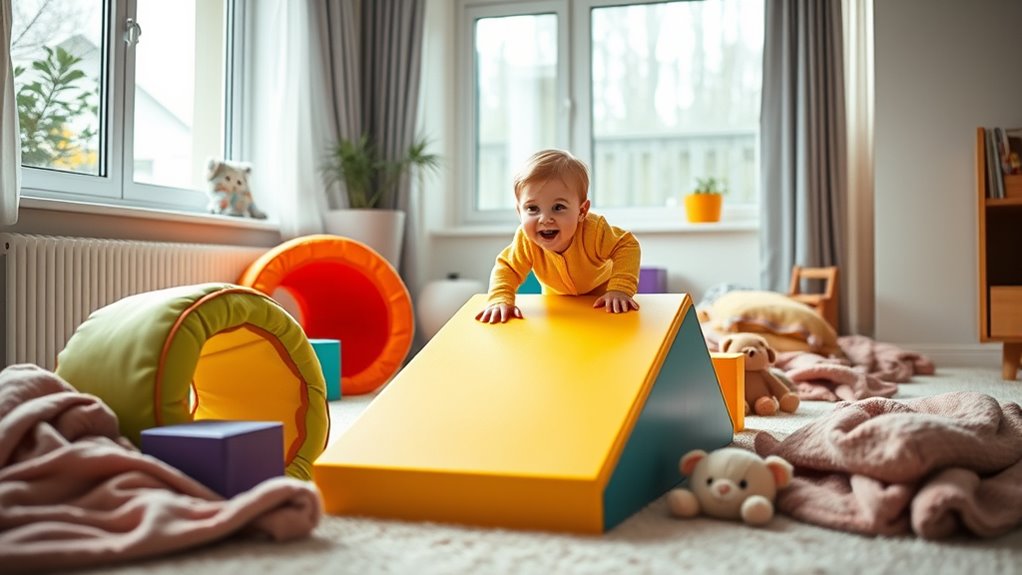
Rainy days can be the perfect time to channel your toddler’s energy into a fun and engaging indoor obstacle course. Set up simple climbing challenges, like stacking cushions or using sturdy furniture, to encourage their natural urge to climb. Incorporate tunnel adventures by using a play tunnel or draping blankets over chairs to create a tunnel space. These activities help develop gross motor skills while keeping your little one active indoors. Make sure the obstacles are safe and age-appropriate, and supervise closely as they navigate the course. You can also add variations, like crawling under or over objects, to keep things interesting. An indoor obstacle course turns a gloomy day into a lively, productive play session that boosts your toddler’s confidence and coordination. Being aware of child development milestones can help you tailor activities to your child’s growth stage and ensure they are both fun and beneficial. Additionally, designing activities around sensory exploration can further enhance your child’s learning and engagement during play. Incorporating problem-solving challenges can also stimulate their cognitive development while they enjoy active play. To maximize the benefits, consider organizing the space to create designated zones for different types of activities, which can help in home organization and maintaining a clutter-free environment. Using age-appropriate equipment ensures safety and encourages confidence during play.
Storytelling and Music Activities to Engage Your Little One

After your toddler has enjoyed climbing and crawling through their obstacle course, engaging their imagination and senses with storytelling and music can provide a delightful change of pace. Sing nursery rhymes together, letting your child feel the rhythm and memorize the words. Bring out simple musical instruments like shakers or drums to make the activity interactive and fun. Use expressive voices and hand gestures to bring stories to life, encouraging your little one to participate actively. This not only strengthens language skills but also builds emotional bonds. Creating a cozy corner for storytelling and music fosters a sense of security and joy. Incorporating voiceover techniques can make storytelling even more captivating and engaging for your child. Utilizing musical instruments during storytelling can enhance sensory development and hold your child’s attention longer. Understanding child development stages can help tailor activities to suit your toddler’s growing abilities. Additionally, incorporating sensory play elements like textured fabrics or visual aids can further stimulate your child’s senses and curiosity. Being mindful of early childhood education principles ensures these activities support overall growth and learning. Your toddler will love feeling involved, and you’ll cherish these shared moments of creativity and connection.
Easy DIY Toys and Games Using Household Items
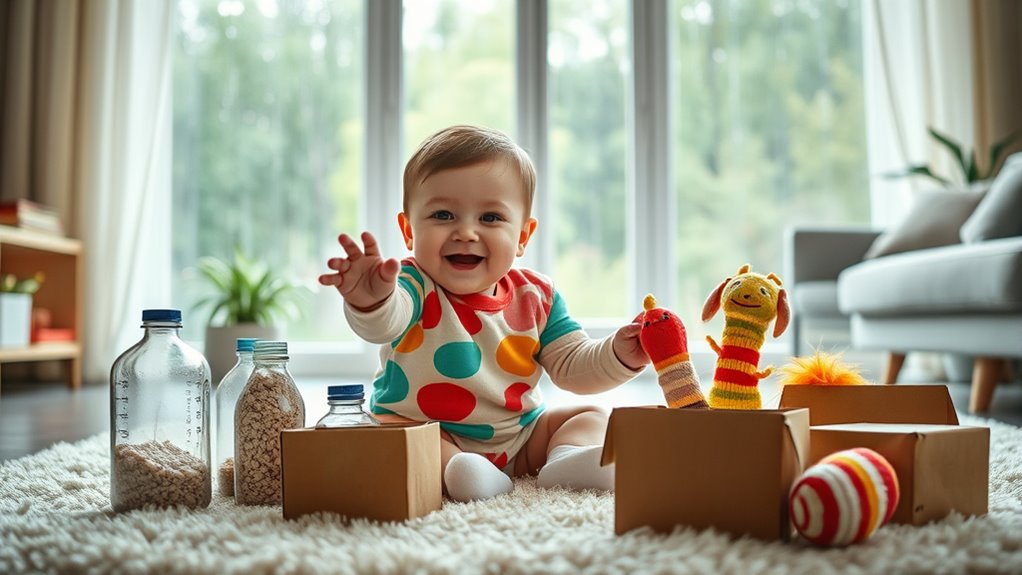
Looking for fun and budget-friendly ways to keep your little one entertained? Try creating DIY sensory bins using household items like rice, pasta, or dried beans. Add small toys or scoops to encourage exploration and fine motor skills. You can also make household puzzle games by hiding objects under cups or in containers, challenging your child to find or sort them. These simple activities stimulate their senses and problem-solving abilities without spending extra money. Recycle old jars, cardboard boxes, and plastic containers to craft engaging toys and games. Incorporating safe and non-toxic materials ensures your toddler’s safety during playtime. With a little creativity, you can turn everyday household items into exciting, educational play experiences that keep your toddler happily occupied indoors.
Frequently Asked Questions
How Can I Ensure Indoor Activities Are Safe for My Baby or Toddler?
To keep your baby or toddler safe during indoor activities, focus on supervision tips like constant eye contact and staying nearby. Use appropriate safety equipment such as outlet covers, corner protectors, and soft mats to prevent injuries. Always assess the environment for hazards before playtime, and remove small objects that could cause choking. Staying attentive and prepared guarantees a fun, safe experience, giving you peace of mind while your little one explores.
What Are Some Age-Appropriate Activities for Different Developmental Stages?
You want to choose age-appropriate activities that support your child’s development. For babies, focus on sensory play with soft textures and gentle sounds, helping their senses grow. For toddlers, incorporate activities that build fine motor skills, like stacking blocks or scribbling. Always supervise closely and adapt activities to match their current abilities. Engaging them in these ways encourages growth and keeps them safely entertained during indoor play.
How Can I Keep My Child Engaged During Long Rainy Days?
To keep your child engaged during long rainy days, try organizing fun rainy day crafts that stimulate creativity and fine motor skills. You can also set up indoor obstacle courses using pillows, furniture, and toys to encourage active play. These activities not only entertain but also promote development. Regularly switching between crafts and physical challenges keeps your child interested and happy while staying indoors.
Are There Any Activities That Support Language Development Indoors?
You might think indoor activities can’t boost language development, but they absolutely can. Try singing nursery rhymes and playing talking games—they’re simple, fun, and highly effective. These activities encourage your child to listen, repeat, and expand their vocabulary. Even on a gloomy day, your voice becomes a powerful tool to foster communication. Regularly engaging in these activities helps your little one develop language skills naturally and joyfully.
How Can I Adapt Activities for Limited Space at Home?
When adapting activities for limited space, you should focus on space-saving solutions and compact activity ideas. Use multi-purpose furniture, like foldable mats and storage bins, to maximize your area. Opt for activities that require minimal space, such as tabletop games or seated storytelling. Keep toys organized and easily accessible to prevent clutter. This way, you create a safe, engaging environment where your little one can enjoy learning and play without feeling cramped.
Conclusion
Rainy days don’t have to mean boredom—you can turn them into fun learning experiences. Engaging your little one in sensory play, crafts, or indoor obstacle courses boosts their development and keeps them happy. Did you know that toddlers who participate in creative activities show a 30% increase in problem-solving skills? So, next time it storms outside, try these activities and watch your baby or toddler thrive while having a blast indoors.

